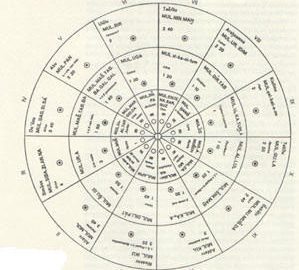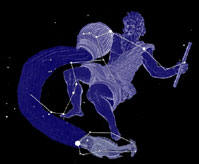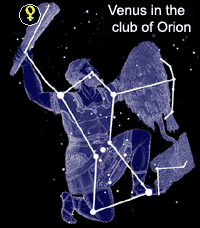Bernadette Brady
May 2005
This newsletter was written as Pope Benedict XVI was elected, but it correctly foresees that his reign as pope is curtailed in some way.
To the Babylonian astronomer/astrologer Jupiter was “The Bearer of Signs to the World” (Rochberg, 2004:190). Its stations, as well as its times of disappearance in the night sky and then its rising before the sun, were all key times in the Babylonian astrological world view. For the great creator god Marduk was deemed to be, or be expressed by, the planet Jupiter. He was the god who created order in the world by killing the dragon of chaos, Tiamat, and split her body in two, placing one half in the earth and the other in the sky.
Having created cosmic order, Marduk was also able, at his whim, to remove that order and disrupt the law-full heavens. This can be seen in a line from the Enuma elis when talking of the powers of Marduk, “In your utterance let the star be destroyed, command again and let the star be restored.” (Rochberg, 2004:200). Thus Jupiter was regarded as an active force which could create order on a small or large scale but could also create disorder in a person’s life or in the life of the kingdom. It was therefore a potent power that needed to be watched. Thus when Jupiter was seen to moved above another planet in the sky, such as Saturn, this could either be the omen of a crown prince rising against his father or an invading general. A Jupiter rising with the new Moon could be the omen of a fortunate union, a fortunate success or even a good harvest. For the Babylonian skywatchers Jupiter was one of the most important wandering stars, viewed as the protagonist of the heavens. Jupiter was Marduk.
Can we apply this thinking to our modern astrology? It so happens that last month (April 2005) a person has come to power whose natal chart would, I think, have raised the eyebrows of more than one Babylonian skywatcher. This is, of course, the new pope, Benedict XVI, [Josef Ratzinger born 16 April 1927 04:15 (-1:00 CET) 12E51 48N15 Marktl am Inn. Source: Niehenke, time officially recorded].
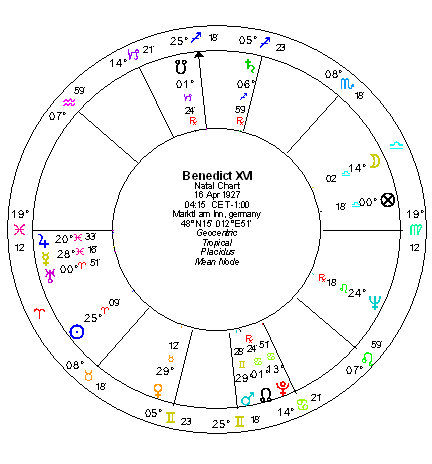
One of the most obvious horoscopic features of the chart of Benedict XVI is Jupiter in Pisces (rulership) on his ascendant. So how would a Babylonian skywatcher read this sky with its predominate Marduk?
On the day of Benedict XVI’s birth there was a sky story in “mid-sentence”. According to Starlight, Jupiter shone brightly at a magnitude of -2.02 (Sirius’ magnitude is -1.46). This magnitude is close to Jupiter’s brightest. Jupiter was also returning to the night sky and rising before the Sun while the full Moon was setting. As well as this, Saturn, symbolic of the king, the one who maintains Marduk’s laws and keeps order down on earth was culminating in the belt of Enlil (stars north of the equator) and above the head of the Scorpion. (In modern terms Saturn is in the heel of Ophiuchus.) Finally the constellation Perseus known to the Babylonians as the “Old Man” stands on the line of the horizon.
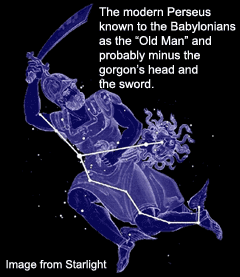
How potent is Marduk? A Question of Jupiter’s Brightness
Jupiter varies in magnitude from -1.6 to – 2.98. This variation of Jupiter’s magnitude depends on several factors. It is at its dimmest magnitude when it is at aphelion (its greatest distance from the sun) which occurs when Jupiter is in the tropical zodiac sign Virgo. It is at its brightest magnitude of -2.98 when Jupiter is at perihelion (closest to the sun) when it is in the sign of Pisces. So every twelve years, when Jupiter is in its old rulership of Pisces it will be at its brightest.
Furthermore, as the Earth moves around its orbit we, during the course of a year, move closer or further from Jupiter. Thus when there is a Jupiter-Sun opposition (which means that the Earth is between Jupiter and the Sun and thus closer to Jupiter), then Jupiter is the brightest it can be in a particular year. When there is a Sun-Jupiter conjunction (indicating that the Earth is on the opposite side to the Sun and Jupiter), then Jupiter is at its dimmest for the year. Therefore we can say that Jupiter is brightest when in Pisces and the Sun is in Virgo (a Sun/Jupiter opposition) and dimmest when Jupiter and the Sun are both in Virgo (Jupiter at aphelion and conjunct the Sun) which interestingly is one of the signs of Jupiter’s detriment.
So at the time of birth for Benedict XVI, Jupiter was visually at its most potent.
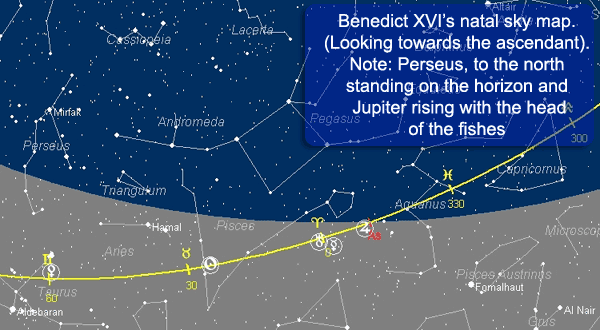
Marduk Returns but the Moon god, Sin flees
In addition to this bright Jupiter, the new pope was born on the day or quite close to the day when this Jupiter had just appeared as a morning rising “star”. For some time it has been an evening setting “star” becoming visible in the early evening light just after sunset but low and to the west. Then it disappears for approximately three to four weeks (the length of time is dependant on the latitude) and then returns to the night sky by rising just before dawn. If we follow the general thinking of that era[1], this is the re-emergence of Marduk from the underworld and represents a time of re-birth and a time of celebration. So Benedict XVI was born not only with Jupiter rising but, more importantly, at the time of the re-birth of Marduk, in the part of the cycle when the god-planet had moved into his brightest period.
So there is a real potency in his sky story and added to this majestic moment of Marduk triumphantly rising from the underworld, the king (Saturn) is seen to be strong, high in the sky and overpowering the great scorpion (see sky map below). It would seem that the combination of Marduk and the strong king is invincible and that such a birth moment is impregnated with the potential for the person to be victorious in all their endeavours, particularly against those enemies belonging to Tiamat, the barbarians, or the unbelievers. There is also the image of the Old Man standing on the horizon seemingly watching these figures. Does this imply that this victory is when he (the child born with this natal sky map) is an old man? Pope Benedict is aged 78 and is the oldest pope elected since Clement XII in 1730 who was one week older than Benedict XVI at his election.
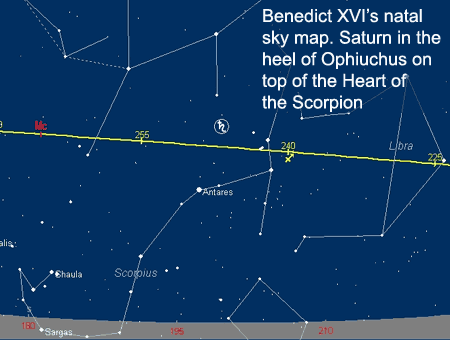
Yet this majestic scene of Marduk and the king at their finest hour seem to lose the support of the Moon god, Sin. He, Sin, is either fearful or disapproving of the potent Marduk and so disappears from the sky just as Marduk becomes visible (the full Moon sets as Jupiter rises). Marduk is effectively abandoned by Sin. The omens of this event imply that the power of the king, or the one being blessed and strengthened by Marduk, is short lived.
The reign of the king, or the victory of the king, is short lived.
So this natal sky map from Starlight talks of a person born to rise above his expected family rank (the bright Jupiter rising) but once he gains nobility, probably in his old age when he appears to be all-conquering or where others flock around him in support, either his reign or his support is short-lived.
There is a deep and ancient story in the sky at the time of Benedict XVI’s birth, a story of success and glory, greatness and nobility but a greatness that, at its pinnacle, appears to be ephemeral.
This is no ordinary Jupiter rising.
[1] This was the thinking of the Egyptian’s at that time with regards to the reappearance of stars in the night sky
Sources
Rochberg, Farncesca (2004) The Heavenly Writing, Divination, Horoscopy, and Astronomy in Mesopotamian Culture. Cambridge, UK:Cambridge University Press.


